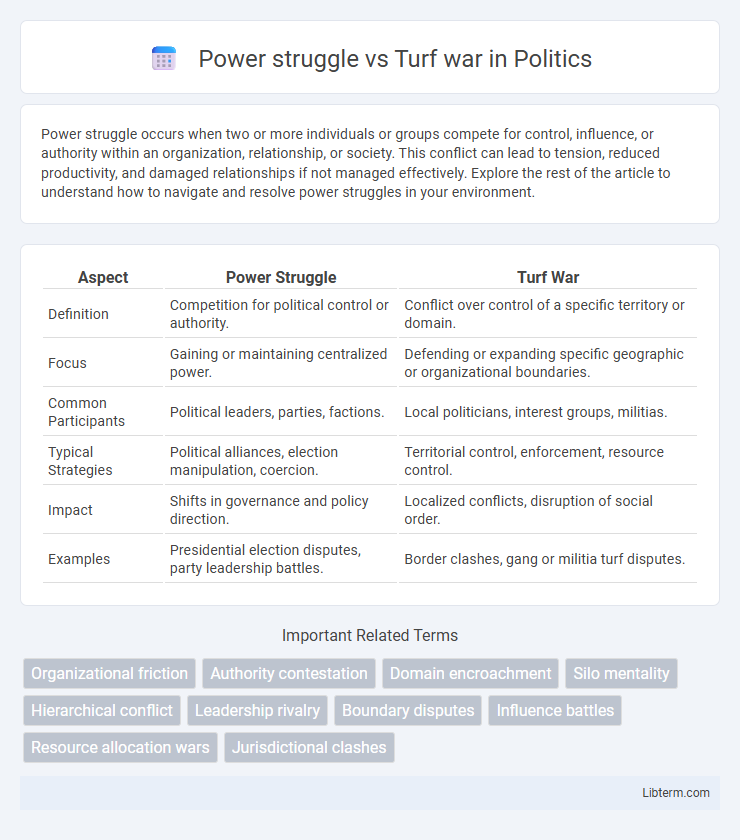Power struggle occurs when two or more individuals or groups compete for control, influence, or authority within an organization, relationship, or society. This conflict can lead to tension, reduced productivity, and damaged relationships if not managed effectively. Explore the rest of the article to understand how to navigate and resolve power struggles in your environment.
Table of Comparison
| Aspect | Power Struggle | Turf War |
|---|---|---|
| Definition | Competition for political control or authority. | Conflict over control of a specific territory or domain. |
| Focus | Gaining or maintaining centralized power. | Defending or expanding specific geographic or organizational boundaries. |
| Common Participants | Political leaders, parties, factions. | Local politicians, interest groups, militias. |
| Typical Strategies | Political alliances, election manipulation, coercion. | Territorial control, enforcement, resource control. |
| Impact | Shifts in governance and policy direction. | Localized conflicts, disruption of social order. |
| Examples | Presidential election disputes, party leadership battles. | Border clashes, gang or militia turf disputes. |
Understanding Power Struggles in Organizations
Power struggles in organizations arise from conflicting interests among individuals or groups vying for control, influence, or decision-making authority. These conflicts often stem from unclear roles, overlapping responsibilities, or competitive ambitions, which disrupt collaboration and productivity. Effective resolution requires clear communication, defined boundaries, and alignment of organizational goals to mitigate the negative impact of both power struggles and turf wars on workplace dynamics.
Defining Turf Wars: Origins and Impacts
Turf wars originate from conflicts over territorial control, resources, or authority within organizations, communities, or between groups, causing disruptions in cooperation and productivity. These disputes often lead to inefficiencies, increased tensions, and weakened organizational structures as parties prioritize dominance over collaboration. Understanding the genesis of turf wars is essential for implementing conflict resolution strategies that restore harmony and optimize operational effectiveness.
Key Differences Between Power Struggles and Turf Wars
Power struggles center on individuals or groups competing for control, authority, or influence within an organization or social hierarchy, emphasizing leadership and decision-making dominance. Turf wars involve conflicts over physical territory, resources, or specific domains where parties seek to protect or expand their area of control. Key differences include the scope of conflict--power struggles target positions of power, while turf wars focus on geographic or resource boundaries--and the underlying motivations, with power struggles driven by ambition and turf wars by defense of established domains.
Causes and Triggers of Power Struggles
Power struggles often stem from a desire for control, influence, or leadership within an organization or group, triggered by ambiguous roles, conflicting goals, or resource scarcity. Turf wars arise specifically from competition over territorial boundaries or domain authority, intensified by overlapping responsibilities, unclear jurisdiction, or perceived threats to status. Both phenomena escalate through communication breakdowns and unaddressed grievances, undermining collaboration and organizational effectiveness.
Factors Driving Turf Wars in the Workplace
Turf wars in the workplace often stem from unclear job roles, limited resources, and competing goals among employees or departments, creating friction and conflicts. Power imbalances and weak leadership contribute significantly by allowing territorial behavior to escalate unchecked. Organizational culture that lacks collaboration and transparency further fuels these disputes, hindering productivity and morale.
Signs and Symptoms of Power Struggles
Power struggles often manifest as persistent conflicts over decision-making authority, frequent clashes in meetings, and attempts to undermine others' influence, while individuals may exhibit defensiveness, resistance to collaboration, and overt competition. Symptoms include increased tension, reduced communication effectiveness, and a notable decline in team morale. Recognizing takeover attempts, passive-aggressive behavior, and faction formation within groups can indicate underlying power struggles.
Indicators and Dynamics of Turf Wars
Indicators of turf wars include persistent conflicts over control of resources, unclear boundaries of authority, and frequent competitive behaviors among departments or teams. Dynamics often involve power struggles where groups seek to expand influence by blocking rivals' access to information, undermining collaboration, and escalating territorial disputes. These conflicts can lead to reduced organizational efficiency and fragmented communication when not effectively managed.
Consequences for Teams and Organizational Culture
Power struggles often lead to reduced collaboration and increased conflict within teams, undermining productivity and morale. Turf wars create silos that hinder communication and knowledge sharing, negatively impacting innovation and organizational agility. Both dynamics erode trust and can result in high employee turnover, deteriorating overall organizational culture.
Strategies to Manage Power Struggles and Turf Wars
Effective strategies to manage power struggles and turf wars include establishing clear communication channels that promote transparency and trust among team members. Implementing conflict resolution processes such as mediation and collaborative problem-solving helps redirect competitive energy toward shared organizational goals. Creating defined roles and responsibilities with aligned incentives reduces ambiguity and minimizes overlapping authorities that often fuel disputes.
Building a Collaborative Culture to Prevent Conflict
Power struggles and turf wars often emerge from unclear roles and competing interests within organizations. Establishing transparent communication channels, defining shared goals, and promoting mutual respect are critical for building a collaborative culture. Implementing team-building activities and conflict resolution training further reduces tensions and fosters a cooperative environment.
Power struggle Infographic

 libterm.com
libterm.com